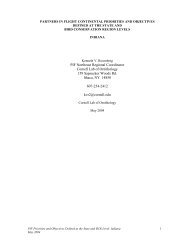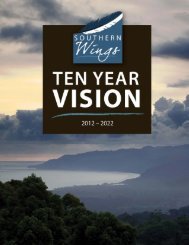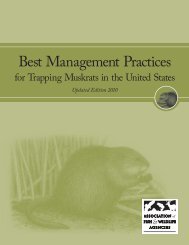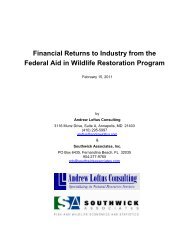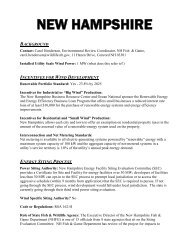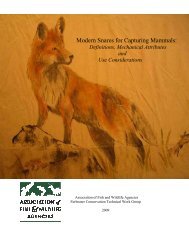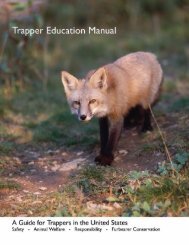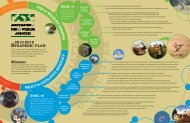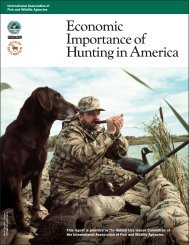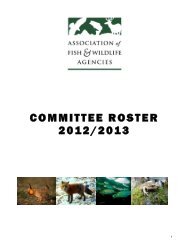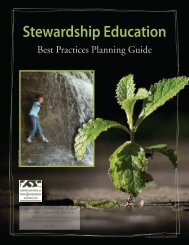American Badger - Association of Fish and Wildlife Agencies
American Badger - Association of Fish and Wildlife Agencies
American Badger - Association of Fish and Wildlife Agencies
Create successful ePaper yourself
Turn your PDF publications into a flip-book with our unique Google optimized e-Paper software.
Best Management Practicesfor Trapping <strong>Badger</strong> in the United States
Best Management Practices (BMPs) are carefully researched educational guidesdesigned to address animal welfare <strong>and</strong> increase trappers’ efficiency <strong>and</strong> selectivity.The extensive research <strong>and</strong> field-testing used to develop BMPs are described in theIntroduction. The evaluation methods used to develop BMPs have been st<strong>and</strong>ardized,enabling BMPs to be easily updated <strong>and</strong> revised as new traps <strong>and</strong> techniques becomeavailable. All traps listed in the BMPs have been tested <strong>and</strong> meet performancest<strong>and</strong>ards for animal welfare, efficiency, selectivity, practicality, <strong>and</strong> safety.Trapping BMPs provide options that allow for discretion <strong>and</strong> decision-making in thefield. Best Management Practices are meant to be implemented in a voluntary <strong>and</strong>educational approach, <strong>and</strong> do not present a single choice that can or must beapplied in all cases. BMPs are the product <strong>of</strong> on-going work that may be updatedas additional traps are identified through future scientific testing.The <strong>Badger</strong> at a GlanceFigure 1. <strong>Badger</strong> (Taxidea taxus)CharacteristicsThe badger (Taxidea taxus) (Figure 1), sometimes referred to as the <strong>American</strong> badgeror North <strong>American</strong> badger (to distinguish it from the Eurasian <strong>and</strong> Honey badgers) isa member <strong>of</strong> the Mustelidae family. <strong>Badger</strong>s have physical characteristics common toother mustelids such as short, powerful legs, <strong>and</strong> a stout, compact, low-slung body.<strong>Badger</strong>s have huge foreclaws (measuring up to 2 inches in length) which they use fordigging burrows <strong>and</strong> hunting prey. Males are typically larger than females withfemales averaging 15.5 pounds <strong>and</strong> males averaging up to 20 pounds. In general,badgers measure between 24 to 29.5 inches in length. <strong>Badger</strong>s are covered witha grizzled, silvery coat <strong>of</strong> coarse hair over the upper body. Feet are black <strong>and</strong> thebelly <strong>and</strong> under-tail are yellowish. The face displays a distinctive black <strong>and</strong> whitepattern, with black “badges” marking the white cheeks <strong>and</strong> a white stripe extendingfrom the nose to the base <strong>of</strong> the head. It should be noted that there are four subspecies<strong>of</strong> badgers in North America <strong>and</strong> these vary slightly in size <strong>and</strong> color as well asdistinctive markings. For example, in one <strong>of</strong> the subspecies, typically found in thelower mid-western <strong>and</strong> southwestern states, T. t. berl<strong>and</strong>ieri, the distinctive white headstripe extends the full length <strong>of</strong> the body instead <strong>of</strong> ending at the base <strong>of</strong> the head.Range<strong>Badger</strong>s range throughout the western <strong>and</strong> central United States, north into centralCanada <strong>and</strong> south into northern Mexico.Habitat<strong>Badger</strong>s prefer open grassl<strong>and</strong>s, tallgrass <strong>and</strong> shortgrass prairie regions <strong>and</strong>parkl<strong>and</strong>s. They may also be found in deserts, forest glades, mountain meadows,<strong>and</strong> brushy areas with soils that allow them to easily dig for prey <strong>and</strong> dig burrows.Burrows are used for denning <strong>and</strong> provide protection from weather, concealmentfrom predators, <strong>and</strong> a safe place to raise young. Burrows may be up to 30 feet inlength <strong>and</strong> 10 feet deep.BADGER2Food Habits<strong>Badger</strong>s are fossorial (adapted to life underground) carnivores. These predators preyprimarily on small rodents (ground squirrels, prairie dogs, etc.), but they also consumereptiles <strong>and</strong> amphibians, ground nesting birds, carrion, <strong>and</strong> insects. They are opportunisticfeeders <strong>and</strong> have been known to eat fish <strong>and</strong> some plant material includingmushrooms, corn, <strong>and</strong> sunflowers.<strong>Association</strong> <strong>of</strong> <strong>Fish</strong> <strong>and</strong> <strong>Wildlife</strong> <strong>Agencies</strong>
Reproduction<strong>Badger</strong>s are solitary animals for most <strong>of</strong> the year, but they exp<strong>and</strong> their territories toactively seek out mates during the breeding season. Males usually do not breed untiltheir second year <strong>of</strong> life <strong>and</strong> may breed with more than one female. Females typicallybreed after their first year. The breeding season occurs from late summer to early fall.<strong>Badger</strong>s experience delayed implantation, typical <strong>of</strong> Mustelids, so actual pregnancies aresuspended until December or as late as February with young usually being born fromlate March to early April. Litters average three young but may range from one to five.<strong>Badger</strong>s are altricial (blind <strong>and</strong> essentially helpless) at birth. Young badgers do notemerge from the den on their own until 5 to 6 weeks <strong>of</strong> age. Juveniles disperse fromthe end <strong>of</strong> June to August. <strong>Badger</strong>s <strong>of</strong>ten live 9 to10 years in the wild.PopulationsThe North <strong>American</strong> badger is listed as a species <strong>of</strong> least concern by the InternationalUnion for Conservation <strong>of</strong> Nature (IUCN) <strong>and</strong> populations appear to be stable overmost <strong>of</strong> the United States. However, in California, the badger is listed as a species<strong>of</strong> special concern due to an apparent reduction in range <strong>and</strong> number in areas where itwas common formerly. In Canada, two badger subspecies (T.t. jacksoni <strong>and</strong> T.t. jeffersoni)are listed as endangered. Humans are the major source <strong>of</strong> mortality for adult badgersthough predators occasionally kill them. Human/wildlife conflicts arise with this speciesprimarily as a result <strong>of</strong> their burrowing activities whereby they damage farm <strong>and</strong> ranchl<strong>and</strong>s <strong>and</strong> pose a hazard to livestock. Animal damage control efforts are <strong>of</strong>ten requiredto reduce these conflicts.General Overview <strong>of</strong> Traps Meeting BMPCriteria for <strong>Badger</strong> in the United StatesOnly foothold restraining traps were used to capture badgers (Table 1) <strong>and</strong> examples,brief descriptions, <strong>and</strong> mechanical details <strong>of</strong> the various devices are given in the nextsection.Table 1. Overview <strong>of</strong> traps meeting BMP criteria for badgers in the United States.Trap CategoryJaw/FrameCharacteristicsInside Jaw/FrameSpread at Dog*Inside Width at Jaw/Frame Hinge Posts*Unmodified 5 1 / 45FootholdPadded 5 3 / 16 67/ 16Offset, laminated<strong>and</strong>/or wide5 1 / 16 – 513/ 16 51/ 16 – 57/ 83*inchesBest Management Practices for Trapping in the United States3 BADGER
Any trap that has similar specifications may be considered a BMP trap regardless <strong>of</strong>br<strong>and</strong> or source <strong>of</strong> modification, although performance information on all other BMPcriteria (see “Criteria for Evaluation <strong>of</strong> Trapping Devices”: Introduction pages 4-6)needs to be considered as well. The trap tested was the Bridger No. 2 coil-springtrap with square jaw, modified with <strong>of</strong>fset, laminated jaws (lamination on bottom <strong>of</strong>jaws), <strong>and</strong> four-coiled.Additional Information• Chain attachment used in trap testing: 30 inch center-mounted with three swivels,one in-line shock spring, <strong>and</strong> anchored with a stake.• Selectivity features: Brass pan tension machine screw; pan tension set so two–fourpounds <strong>of</strong> pressure triggered the trap, <strong>and</strong> was checked <strong>and</strong> readjusted as neededafter every capture.• Special considerations for practicality: This device also meets BMP criteria forbobcats, red foxes, Eastern coyotes <strong>and</strong> Western coyotes.Average Mechanical Description <strong>and</strong> AttributesInside jaw spread (at dog): 5 13/16 inchesInner width: 5 7/16 inchesInside width at jaw hinge posts: 5 7/8 inchesJaw width: 1/2 inches smooth round jawJaw thickness: 3/8 inchesJaw <strong>of</strong>fset: 3/16 inchesMain Trap Springs: Four 0.146 inch diameter wire coil-springsBase Plate: Reinforced, D-ring chain attachmentAny trap that has similar specifications may be considered a BMP trap regardless <strong>of</strong>br<strong>and</strong> or source <strong>of</strong> modification, although performance information on all other BMPcriteria (see “Criteria for Evaluation <strong>of</strong> Trapping Devices”: Introduction pages 4–6)needs to be considered as well. The trap tested was the Sterling MJ600 <strong>of</strong>fsetcoil-spring trap, four-coiled.Additional Information• Chain attachment used in trap testing: 30 inch center-mounted with three swivels,one in-line shock spring, <strong>and</strong> anchored with a stake.• Special considerations for practicality: This device also meets BMP criteria forbobcats <strong>and</strong> Western coyotes.Best Management Practices for Trapping in the United States7 BADGER



